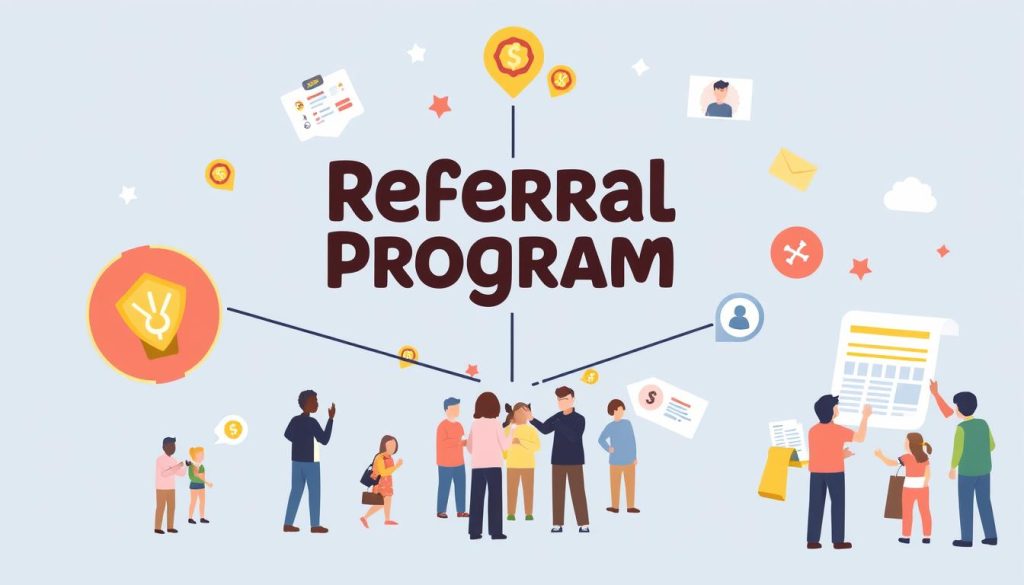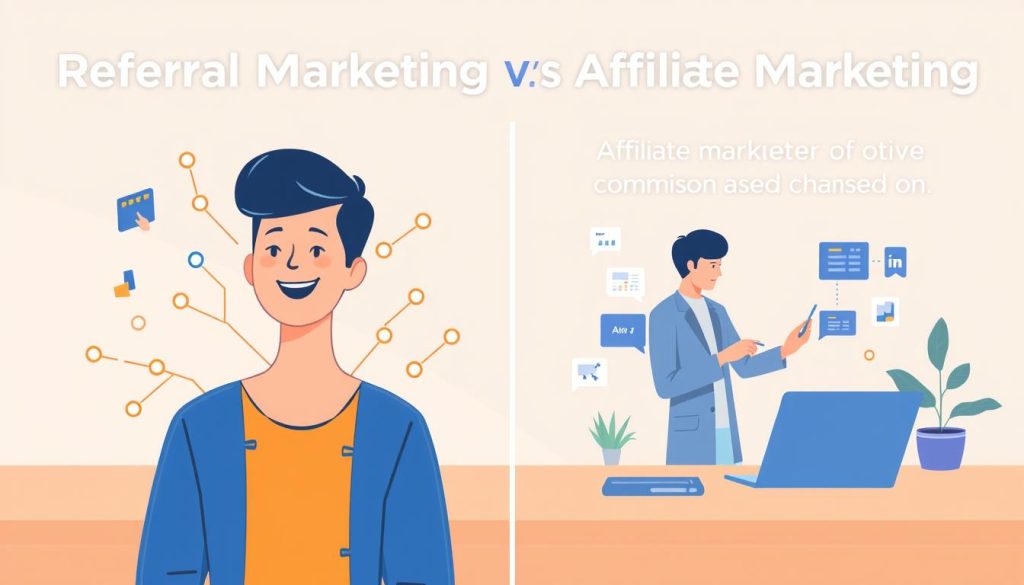In today’s competitive business landscape, building trust with potential customers is paramount. Studies have shown that 84% of customers trust personal recommendations from people they know more than any advertising that comes from a brand. This is where referral marketing comes into play, leveraging the power of personal recommendations to acquire new customers.
By implementing a structured program, businesses can turn their existing customers into brand advocates who actively promote their business. This not only enhances customer loyalty but also drives growth through effective marketing strategy.
Table of Contents
Key Takeaways
- Referral marketing is a highly effective strategy for acquiring new customers.
- A structured program can significantly enhance customer loyalty.
- Personal recommendations have a higher conversion rate compared to traditional marketing methods.
- Businesses can drive growth by leveraging their existing customers as brand advocates.
- Referral marketing can result in a higher lifetime value for new customers.
Understanding Referral Marketing
Referral marketing is a powerful strategy that leverages the trust and influence of existing customers to drive business growth. By understanding the principles of referral marketing, businesses can create effective campaigns that encourage referrals.
What Is Referral Marketing?
Referral marketing is a structured program designed to incentivize customers to refer new customers to a business. This is achieved through clear incentives, tracking mechanisms, and promotional strategies. A well-designed referral program can significantly enhance a brand‘s visibility and credibility.
How Referral Marketing Differs from Word-of-Mouth
While word-of-mouth marketing occurs naturally when customers share their experiences without any formal incentive, referral marketing formalizes this process. Referral marketing creates intentional pathways for recommendations with measurable outcomes and rewards. Unlike word-of-mouth, which is passive and unpredictable, referral marketing is active and strategic.
| Characteristics | Word-of-Mouth | Referral Marketing |
|---|---|---|
| Incentives | No formal incentives | Clear incentives offered |
| Tracking | No formal tracking | Mechanisms for tracking referrals |
| Strategy | Passive and spontaneous | Active and strategic |
By understanding these differences, businesses can effectively implement referral marketing strategies to complement their existing marketing efforts.
The Power of Referral Marketing
Referral marketing leverages the trust that exists between friends and family to promote business growth. This form of marketing is particularly effective because it comes with a personal endorsement, making it more credible than traditional advertising methods.
Key Statistics That Prove Its Effectiveness
Research has consistently shown that referral marketing is a highly effective strategy. Some key statistics include:
- Approximately 80% of consumers trust recommendations from people they know, making personal referrals one of the most trusted forms of marketing.
- In contrast, 75% of consumers believe companies are not truthful in their advertising, highlighting the credibility gap that referral marketing can bridge.
- People are naturally hesitant to recommend businesses that provide poor experiences, which means referrals typically come with an implicit quality guarantee.
| Statistic | Percentage | Implication |
|---|---|---|
| Consumers trusting referrals | 80% | High credibility of personal referrals |
| Consumers distrusting company ads | 75% | Credibility gap for traditional advertising |
Why Customers Trust Recommendations from Friends
The psychological principle of social proof is particularly powerful when it comes from someone in a person’s immediate social circle. This creates a stronger influence than anonymous reviews or testimonials because it reduces the perceived risk for new customers, shortening the decision-making process and increasing conversion likelihood.
By leveraging referral marketing, businesses can tap into this trust, creating a more effective and sustainable marketing strategy. As a result, customers are more likely to engage with a brand that is recommended by someone they trust.
Benefits of Implementing a Referral Marketing Strategy
A well-crafted referral marketing strategy can bring numerous advantages to a business, from increased conversions to enhanced customer loyalty. By incentivizing existing customers to refer new customers, businesses can tap into a powerful marketing channel that drives growth and revenue.
Higher Conversion Rates
Referral marketing leads to higher conversion rates because referred customers are more likely to trust a brand recommended by someone they know. According to the data, « Vos clients référents font également beaucoup de travail dans l’entonnoir de conversion. Ils peuvent répondre aux questions et inspirer confiance dans le processus d’achat. » This means that referred customers are already pre-sold on the product or service, making them more likely to convert.
- Referred customers arrive with higher trust and readiness to purchase.
- Referring customers often pre-sell the offering by answering questions and addressing concerns.
Lower Customer Acquisition Costs
Referral marketing is a cost-effective way to acquire new customers. By leveraging existing customers, businesses can reduce their customer acquisition costs. Each successful referral reinforces the brand’s credibility and trustworthiness, making it easier to acquire new customers at a lower cost.
Increased Customer Loyalty
Referral programs not only bring in new customers but also strengthen the bond with existing ones. When customers participate in a referral program, they feel more engaged and loyal to the brand. This loyalty is crucial for long-term business success, as loyal customers are more likely to continue doing business with the brand.
Building Social Proof
Referral marketing naturally generates social proof as customers publicly endorse products or services to people they know. The cumulative effect of multiple referrals creates a powerful perception that the brand is widely trusted and recommended. This social proof is invaluable for attracting new customers and growing the business.
« The cumulative effect of multiple referrals creates a powerful perception that your brand is widely trusted and recommended. »
Essential Components of a Successful Referral Program
The success of a referral program hinges on several key elements that work together to create a seamless and engaging experience for your customers. A well-designed referral program can significantly enhance customer loyalty and drive business growth.
Clear and Compelling Incentives
Offering clear and compelling incentives is crucial for motivating customers to participate in your referral program. These incentives should be valuable enough to encourage sharing, yet aligned with your business goals. Consider what rewards will resonate with your customers, whether it’s monetary discounts, exclusive services, or other benefits that enhance their experience with your brand.
- Provide rewards that are perceived as valuable by your target audience.
- Ensure that the incentives are easy to understand and redeem.
- Consider tiered rewards to encourage multiple referrals.
Simple Sharing Process
A successful referral program must have a simple and frictionless sharing process. Even if your customers love your brand and your rewards are attractive, they may be deterred by a complicated referral process. To avoid this, make sure your referral process is:
- Easy to complete in just a few clicks.
- Available across multiple channels (email, social media, messaging apps, shareable links).
- Optimized for mobile devices, where many social interactions occur.
- Pre-populated with compelling but customizable content.
By streamlining the sharing process, you can increase customer participation and make it more likely that they will refer others to your business.
Types of Referral Marketing Programs
Businesses can choose from multiple referral marketing program types, each with its unique benefits and challenges. The key to a successful referral strategy lies in understanding these differences and selecting the program that best aligns with your business goals.
Double-Sided Incentive Programs
Double-sided incentive programs reward both the referrer and the new customer, creating a win-win situation that encourages participation. This type of referral program is particularly effective because it motivates both parties involved.
For instance, a company might offer a discount to both the referrer and the new customer on their next purchase. This approach not only incentivizes existing customers to refer new ones but also makes the offer more appealing to potential customers.
One-Sided Reward Programs
One-sided reward programs, on the other hand, provide incentives to either the referrer or the new customer, but not both. While less common than double-sided programs, they can be effective in certain situations.
- Referrer-only rewards work best when your product has high inherent value that new customers already desire, making additional incentives unnecessary.
- Customer-only rewards can be effective when you want to rapidly acquire new customers and your existing customers have strong brand loyalty.
- One-sided programs are typically simpler to implement and can be more cost-effective for businesses with tight marketing budgets.
As noted by marketing expert Jonah Berger, « Word-of-mouth isn’t just about referrals; it’s about creating a conversation around your product or service. » A well-designed one-sided reward program can spark this conversation, driving growth for your business.
| Program Type | Description | Effectiveness |
|---|---|---|
| Double-Sided Incentive | Rewards both referrer and new customer | Highly effective for encouraging participation |
| One-Sided Reward | Rewards either referrer or new customer | Effective in specific situations, simpler to implement |
By understanding the strengths and weaknesses of each type of referral program, businesses can make informed decisions about their referral marketing strategies, ultimately driving growth and increasing customer loyalty.
How to Implement a Referral Marketing Strategy

To create a successful referral program, you need to start with a clear understanding of your goals. Implementing a referral marketing strategy can be a powerful way to drive business growth, but it requires careful planning and execution.
Setting Clear Goals for Your Program
Setting clear goals is essential for the success of your referral program. You need to define what you want to achieve, whether it’s increasing customer acquisition, boosting sales, or improving brand awareness. Having specific, measurable objectives will help you design a more effective program.
Identifying Your Target Audience
Understanding your target audience is crucial for creating a referral program that resonates with them. You need to know their preferences, behaviors, and pain points to design incentives and messaging that appeal to them. This will help you increase participation and referrals.
Designing Your Referral Process
A simple and seamless referral process is vital for the success of your program. You need to make it easy for customers to refer friends and family, and ensure that the process is straightforward and rewarding. This can include creating dedicated landing pages, designing eye-catching email templates, and producing social media-friendly assets.
Creating Promotional Materials
Developing compelling promotional materials is key to promoting your referral program effectively. You need to create materials that clearly communicate the value proposition of your program, such as dedicated landing pages, email templates, and social media assets. These materials should highlight the rewards and make it easy to start referring.
Some effective strategies for promoting your referral program include adding details to your newsletter, having opt-ins on your website, capturing customer emails through pop-up widgets, sending specific referral emails to loyal customers, and including physical cards in order packages. By using these strategies, you can increase visibility and drive participation in your referral program.
Choosing the Right Referral Incentives

The right referral incentives can significantly boost customer engagement and loyalty. When designing a referral program, it’s crucial to select incentives that align with your customer base and business model.
Monetary Rewards vs. Non-Monetary Rewards
One of the key decisions in setting up a referral program is whether to offer monetary or non-monetary rewards. Monetary rewards, such as cash or discounts, are often effective because they provide immediate value to customers. On the other hand, non-monetary rewards, like exclusive access to new products or services, can create a sense of prestige and loyalty.
If referrers purchase frequently, it’s beneficial to tie the rewards back to your business, offering store credits, discounts, or free products. Conversely, if referrers aren’t likely to make a purchase in the near future, consider offering cash, gift cards to other businesses, or tangible rewards that don’t directly relate to your business.
Tailoring Incentives to Your Customer Base
Tailoring your referral incentives to match the specific preferences and purchasing patterns of your customer base is vital. For customers who purchase frequently, rewards that encourage repeat business, such as store credits, product discounts, or loyalty points, are effective. For subscription-based businesses, incentives that extend or enhance the subscription, like discounts on subscriptions, a free month, or upgrades, often work best.
- For customers with longer purchase cycles, consider standalone rewards like cash incentives or third-party gift cards.
- Segmenting your incentive structure to offer different rewards to different customer groups based on their value and behavior patterns can also be effective.
By understanding your customers’ behavior and preferences, you can design a referral program that not only attracts new customers but also retains existing loyal customers, ultimately driving the value of your referral marketing strategy.
Referral Marketing Software and Tools
![]()
To maximize the effectiveness of a referral marketing strategy, businesses need the right software and tools. Managing a successful referral program involves tracking referrals, conversions, and follow-ups, which can be efficiently handled with specialized software.
Features to Look for in Referral Software
When selecting referral marketing software, several key features should be considered. These include:
- Easy setup and integration with existing e-commerce platforms
- Customizable templates to match your brand’s identity
- Robust tracking and analytics capabilities
- Multi-channel sharing options to reach a wider audience
- Fraud prevention measures to ensure the integrity of your program
These features are crucial for creating a seamless and effective referral program that benefits both the referrer and the referee.
Popular Referral Marketing Platforms
Several platforms stand out for their excellence in referral marketing. ReferralCandy is a popular choice for e-commerce businesses, offering easy setup and customizable templates.
Referral Rock provides flexible solutions with robust customization options and multi-channel sharing.
Other notable platforms include Ambassador, which offers enterprise-level solutions with advanced segmentation and analytics; Friendbuy, specializing in direct-to-consumer brands with features like widget customization; and Mention Me, focusing on omnichannel capabilities for referrals both online and offline.
Promoting Your Referral Program Effectively
To maximize the potential of your referral program, effective promotion is crucial. A well-structured promotional strategy can significantly enhance the visibility and success of your program.
Email Marketing Strategies
Email marketing is a powerful tool for promoting your referral program. You can send targeted campaigns to your existing customers, highlighting the benefits and simplicity of your program. Use clear and compelling calls-to-action to encourage participation. For instance, you can create a dedicated email series that explains how the program works and the rewards customers can earn.
- Send regular newsletters with updates about your referral program.
- Use segmentation to target customers who are most likely to participate.
- Include clear calls-to-action in your emails.
Social Media Promotion
Social media platforms offer a vast opportunity to promote your referral program. Create engaging content that explains the benefits of your program and encourages sharing. You can also use paid social media ads to reach a wider audience. Ensure that your referral program is easily accessible and shareable on these platforms.
- Share engaging content that highlights the benefits of your referral program.
- Utilize paid social media ads to increase reach.
- Make your referral program easily shareable.
Website Integration
Integrating your referral program into your website is essential for its success. Create dedicated landing pages that clearly explain how your program works. You can also add referral program links to high-visibility areas such as your homepage and navigation menu.
- Integrate your referral program prominently into your website.
- Use post-purchase referral prompts to encourage participation.
- Create in-account referral sections for logged-in users.
Tracking and Measuring Referral Program Success
A successful referral program requires ongoing assessment and optimization to achieve desired results. To ensure your program is performing well, you need to track and measure its success regularly.
Key Performance Indicators (KPIs) to Monitor
To evaluate the effectiveness of your referral program, you need to monitor key performance indicators (KPIs). These may include referral rates, conversion rates, customer acquisition costs, and customer lifetime value. By tracking these KPIs, you can identify areas for improvement and optimize your program for better results.
- Referral rate: The number of referrals generated by your program.
- Conversion rate: The percentage of referrals that result in new customers.
- Customer acquisition cost: The cost of acquiring new customers through your referral program.
- Customer lifetime value: The total value of customers acquired through your referral program.
| KPI | Description | Target Value |
|---|---|---|
| Referral Rate | Number of referrals generated | 100 referrals/month |
| Conversion Rate | Percentage of referrals converted to customers | 20% |
| Customer Acquisition Cost | Cost of acquiring new customers | $50/customer |
Analyzing and Optimizing Your Program
Regular analysis of your referral program data is crucial to identifying trends, bottlenecks, and opportunities for improvement. By conducting A/B testing on key program elements, such as incentive structures and messaging, you can optimize your program for better performance. Additionally, gathering feedback from program participants can help you identify pain points and areas for enhancement.
By making data-driven adjustments to your program, you can continuously refine your approach and achieve better results. Remember, the key to a successful referral program is ongoing assessment and optimization.
Common Mistakes to Avoid in Referral Marketing
To maximize the potential of referral marketing, it’s crucial to steer clear of several common errors. By understanding and avoiding these pitfalls, businesses can ensure their referral programs are effective and yield the desired results.
Overly Complex Processes
One of the most significant mistakes in referral marketing is creating overly complex processes. When the referral process is too complicated, customers are less likely to participate. Simplifying the process and making it easy for customers to refer others is crucial. This can be achieved by providing clear instructions and minimizing the steps required to complete a referral.
Inadequate Promotion
Inadequate promotion is another common mistake. If customers are not aware of the referral program, they cannot participate. Effective promotion through various channels such as email, social media, and website integration is essential to keep the program top of mind for customers.
Unattractive Incentives
Offering unattractive incentives can also hinder the success of a referral program. The rewards offered should be appealing and of significant value to motivate customers to refer others. Research has shown that non-cash incentives can be 24% more effective than cash incentives, emphasizing the importance of choosing the right type of referral incentives.
Some key considerations for avoiding these mistakes include:
- Avoiding rewards that are too small or lack appeal.
- Ensuring that the incentive structure is fair and benefits both the referrer and the new customer.
- Tailoring incentives to align with the preferences and values of your customer base.
- Simplifying reward structures to avoid confusion.
- Ensuring timely delivery of rewards without excessive redemption requirements.
Difference Between Referral Marketing and Affiliate Marketing

While both referral and affiliate marketing aim to drive sales, they operate on different principles and are suited for different business needs. Referral marketing focuses on encouraging satisfied customers to recommend a business to their personal networks, often in exchange for incentives. This strategy leverages the trust and emotional connection between customers and their friends or family. On the other hand, affiliate marketing involves partnering with content creators or influencers who promote products or services to their followers, typically earning a commission for each sale generated through their unique referral link.
Referral marketing tends to be more personal and is driven by customer satisfaction and loyalty. In contrast, affiliate marketing can reach a broader audience and is often used for products that require detailed explanations or comparisons. Understanding these differences is crucial for businesses to choose the most effective marketing strategy for their specific needs.
Key Distinctions in Approach and Implementation
The approach and implementation of referral and affiliate marketing differ significantly. Referral marketing relies on the existing customer base to spread the word about a product or service, typically through personal recommendations. Affiliate marketing, however, involves recruiting affiliates who are not necessarily customers but are interested in promoting products to their audience. This fundamental difference affects how businesses structure their referral marketing and affiliate programs, including the incentives they offer and the tracking mechanisms they use.
When to Use Each Strategy
Businesses should consider using referral marketing when they have a satisfied customer base that can authentically recommend their products or services. It’s ideal for products with high emotional appeal that customers naturally want to share. Affiliate marketing is more suitable for products that benefit from detailed explanations or comparisons and have a broader market appeal. Companies can also use both strategies simultaneously but with different goals—referrals for trust-based acquisition and affiliates for broader market reach, thereby optimizing their overall marketing strategy.
Case Studies: Successful Referral Marketing Examples
The effectiveness of referral marketing is best illustrated through real-world examples of companies that have implemented successful referral programs. By examining these referral program examples, businesses can gain valuable insights into strategies that drive growth and customer engagement.
Dropbox’s Space Incentive Program
Dropbox’s referral program is a classic example of a successful incentive-based strategy. By offering additional storage space for both the referrer and the new user, Dropbox created a win-win situation that encouraged users to invite friends and family to join the platform. This simple yet effective program helped Dropbox grow its user base significantly.
PayPal’s Cash Reward Strategy
PayPal’s referral program leveraged cash rewards to incentivize users to refer new customers. By offering a cash bonus for both the referrer and the new user, PayPal created a powerful motivator that drove significant growth. This strategy not only attracted new users but also increased customer loyalty among existing users.
Airbnb’s Travel Credit System
Airbnb implemented a referral program that rewarded users with travel credits for successful referrals. This strategy aligned perfectly with Airbnb’s service, providing a relevant and appealing incentive. The travel credit system encouraged users to refer friends and family, expanding Airbnb’s user base while reinforcing customer loyalty.
Tesla’s Tiered Referral Program
Tesla has implemented various iterations of referral programs over the years, often featuring tiered rewards that increase in value based on the number of successful referrals. Tesla’s referral program included unique experiential rewards like exclusive event invitations and factory tours, aligning perfectly with their brand positioning. By leveraging scarcity and exclusivity, Tesla offered limited-edition products only available through their referral program, tapping into the natural enthusiasm of Tesla owners and turning them into passionate advocates. This approach demonstrates how a company like Tesla can use exclusive, non-monetary incentives to drive referrals without discounting their products.
These examples illustrate the diversity and creativity possible in referral marketing. Each of these companies has achieved significant success by tailoring their referral programs to their specific business models and customer bases.
Adapting Referral Marketing for Different Business Models
Different business models require unique referral marketing approaches to achieve optimal results. The versatility of referral marketing allows it to be effective across various industries, from e-commerce to B2B services.
Referral Strategies for E-commerce Businesses
E-commerce businesses can significantly benefit from referral marketing by incentivizing customers to share products with their networks. Offering discounts or free products for successful referrals can drive sales and increase brand visibility.
Referral Programs for Service-Based Companies
Service-based companies can leverage referral marketing by focusing on the quality of service and encouraging happy clients to refer others. Offering service upgrades or exclusive benefits for referrals can be particularly effective.
B2B Referral Marketing Approaches
B2B businesses can adopt referral marketing strategies similar to Google’s successful program, which rewards referrals based on the number of users. Key approaches include:
- Implementing value-based rewards that scale with the size of the referred business.
- Creating dedicated referral channels for partners, vendors, and existing clients.
- Offering both company-level incentives and individual rewards.
By tailoring referral marketing strategies to their specific business models, companies can enhance customer engagement, drive growth, and improve brand loyalty.
Integrating Referral Marketing with Your Overall Marketing Strategy
To maximize the impact of your referral marketing efforts, it’s crucial to integrate it seamlessly with your overall marketing strategy. This integration ensures that your referral program is not a standalone initiative, but a vital part of your customer’s journey. By doing so, you can create a cohesive customer experience that fosters loyalty and drives growth.
Aligning Referral Programs with Brand Values
Aligning your referral program with your brand values is essential to maintaining consistency across all marketing channels. This alignment helps to build trust with your customers and reinforces your brand’s message. As noted by marketing experts, « A brand’s values are the foundation upon which all marketing efforts should be built. » Therefore, it’s vital to ensure that your referral program reflects these values.
Creating a Cohesive Customer Experience
Creating a cohesive customer experience is critical to the success of your referral marketing program. This involves designing your referral program as an integral part of the overall customer journey. To achieve this, consider the following strategies:
- Ensure consistent branding, messaging, and user experience across all touchpoints in the referral process.
- Create special onboarding experiences for referred customers that acknowledge their friend connection and make them feel valued from the start.
- Integrate referral opportunities at natural points in the customer lifecycle where satisfaction is typically highest.
By implementing these strategies, you can create a seamless customer experience that not only rewards referrals but also strengthens your brand’s overall marketing efforts.
Conclusion: Harnessing the Full Potential of Referral Marketing
Harnessing the full potential of referral marketing can be a game-changer for your business. By encouraging customers to share their positive experiences, you create a sustainable engine for high-quality customer acquisition. Effective referral marketing combines attractive incentives, simple processes, and consistent promotion. As you implement your marketing strategy, continuously test and optimize your approach. With the right program, satisfied customers become a powerful extension of your marketing team, driving growth through trusted recommendations, ultimately boosting your business growth.
FAQ
What is the primary goal of a referral program?
The primary goal of a referral program is to incentivize existing customers to refer new customers, thereby driving business growth and increasing customer acquisition.
How do I choose the right incentives for my referral program?
To choose the right incentives, consider what motivates your customer base. You can opt for monetary rewards, such as discounts or cash, or non-monetary rewards, like exclusive services or gift cards.
What are the key components of a successful referral marketing strategy?
A successful referral marketing strategy includes clear and compelling incentives, a simple sharing process, and effective promotion through various channels, such as email and social media.
How can I measure the success of my referral program?
To measure the success of your referral program, track key performance indicators (KPIs) such as the number of referrals, conversion rates, and customer acquisition costs.
What are some common mistakes to avoid in referral marketing?
Common mistakes to avoid include overly complex processes, inadequate promotion, and unattractive incentives. Ensure that your referral program is easy to understand and participate in.
How can I promote my referral program effectively?
Promote your referral program through various channels, including email campaigns, social media, and website integration, to reach a wider audience and encourage participation.
Can referral marketing be used for B2B businesses?
Yes, referral marketing can be effective for B2B businesses. Tailor your referral program to your business needs and target audience to drive growth and customer acquisition.
How do I integrate referral marketing with my overall marketing strategy?
Align your referral program with your brand values and create a cohesive customer experience by integrating it with your overall marketing strategy, including email, social media, and content marketing.





